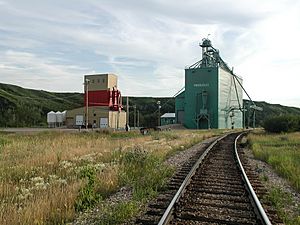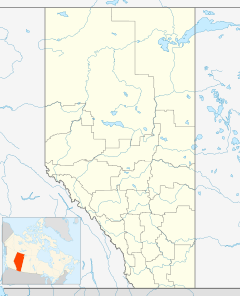Rosebud, Alberta facts for kids
Quick facts for kids
Rosebud
|
|
|---|---|
|
Hamlet
|
|

Rosebud Grain Elevator
|
|
| Country | Canada |
| Province | Alberta |
| Region | Southern Alberta |
| Municipal district | Wheatland County |
| Dissolved | January 1, 1946 |
| Area
(2021)
|
|
| • Land | 0.73 km2 (0.28 sq mi) |
| Population
(2021)
|
|
| • Total | 112 |
| • Density | 153.4/km2 (397/sq mi) |
| Time zone | UTC−07:00 (MST) |
| • Summer (DST) | UTC−06:00 (MDT) |
| Postal code |
T0J 2T0
|
| Area code(s) | +1-403 |
| Highways | Highway 840 |
| Waterways | Rosebud River |
Rosebud, Alberta is a small community called a hamlet in southern Alberta, Canada. It is part of Wheatland County. Rosebud used to be a village, but it changed its status on January 1, 1946. It then became part of the Municipal District of Grasswold No. 248.
Rosebud is found along Highway 840. It is about 100 kilometers (62 miles) northeast of Calgary. It is also about 25 kilometers (16 miles) southwest of Drumheller. The hamlet is in a cozy valley next to the Rosebud River. This area is close to the famous Canadian Badlands. The Blackfoot people called this place Akokiniskway. This name means "by the river of many roses."
Contents
History of Rosebud
The hamlet of Rosebud was started in 1885 by James Wishart. He was traveling with his family on the Gleichen Trail to Montana. One morning, they woke up to find the river valley covered in wild roses. These are Alberta's official flower. Wishart reportedly said, "Here's the promised land, we go no further."
Artists and the Valley
The beautiful valley has drawn many people over the years. These include nature lovers and artists. Famous artists A. Y. Jackson and H. G. Glyde visited in 1944. They were members of the Group of Seven. They spent a summer painting in the area.
Industries and Changes
For many years, farming and coal mining were the main jobs in Rosebud. In 1972, the Severn Creek School closed down. This was part of a province-wide plan to combine schools. Children from Rosebud then had to take buses to schools in Standard and Drumheller.
Because of this, many local businesses shut down. The number of people living in the hamlet dropped to less than a dozen. However, the farming community, with about 400 people, still supports a seed cleaning plant.
The Rise of the Arts
In 1973, a group of young adults from Calgary started something new. They brought about 40 teenagers to Rosebud for a camp. This first event led to a summer camp. It was first funded by the Alberta government. Later, it was supported by Crescent Heights Baptist Church in Calgary as the Rosebud Camp of the Arts.
In 1977, a high school was opened. It used the old buildings in town as classrooms. This school focused on practical skills, visual arts, music, and performing arts. In the 1980s, the Rosebud School of the Arts began putting on plays. This eventually grew into the Rosebud Theatre. The school then focused on education after high school.
Today, Rosebud Theatre is a professional company. It offers shows all year round. It is a popular place for tourists. People come to visit from Calgary and Drumheller.
People in Rosebud
In the 2021 Census, 112 people lived in Rosebud. They lived in 43 of the 54 homes there. This was an increase from 87 people in 2016. Rosebud has a land area of 0.73 square kilometers (0.28 square miles). This means there were about 153 people per square kilometer in 2021.
In the 2016 Census, 87 people lived in Rosebud. They lived in 29 of the 30 homes. This was a small change from 88 people in 2011. The land area was 0.29 square kilometers (0.11 square miles) in 2016.
What Rosebud Does
Today, the main jobs in Rosebud are related to tourism and the arts. The Rosebud Theatre brings about 40,000 visitors to the hamlet each year. This theatre started from a church program for young people in Calgary. Farming, along with oil and gas production, are also important jobs in the areas around Rosebud.
Images for kids



